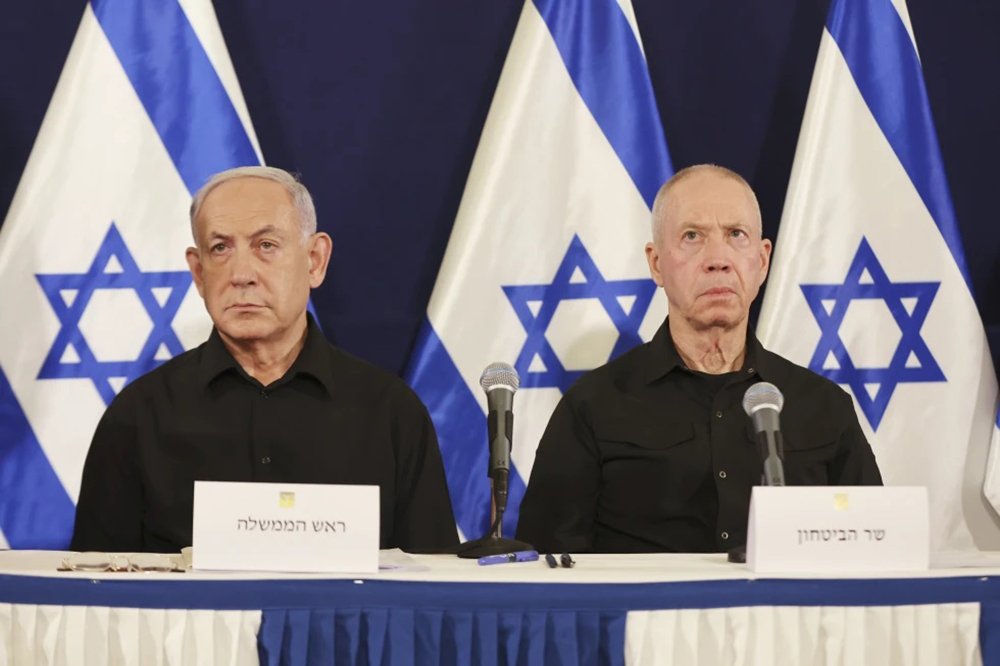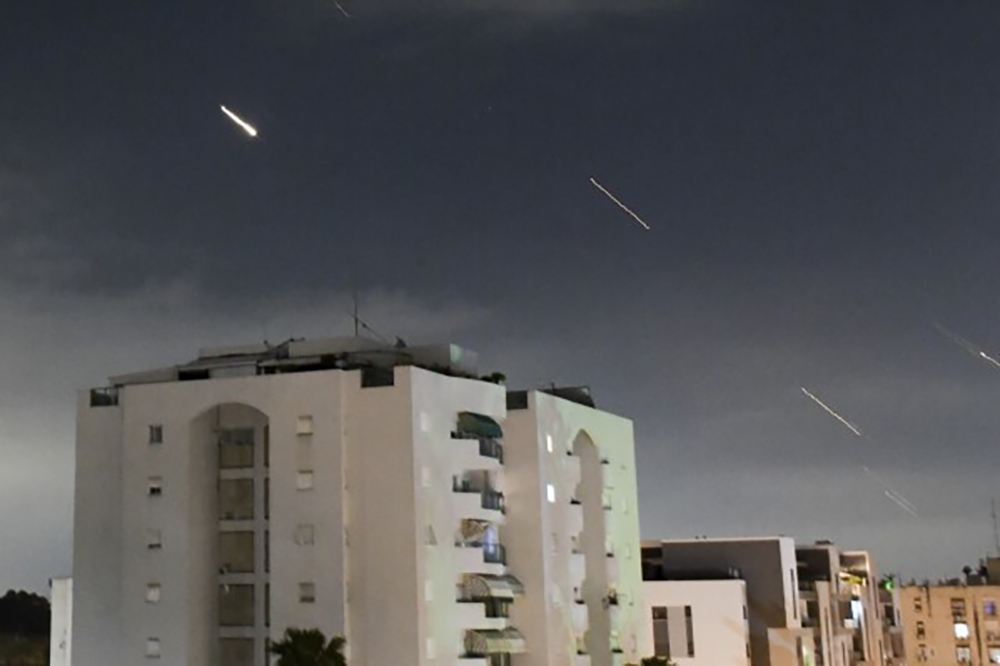|
Getting your Trinity Audio player ready...
|
Edited by: Fern Sidman
The United States has confirmed the deployment of the THAAD advanced aerial defense system to Israel, following a series of missile strikes by Iran earlier this year. According to the Department of Defense, the decision was approved by Secretary of Defense Lloyd Austin as part of a broader strategy to reinforce Israel’s air defenses amid escalating regional tensions. As The Jewish News Syndicate reported, this move is intended to strengthen Israel’s capacity to defend itself against potential future missile attacks from Iran.
The THAAD, or Terminal High Altitude Area Defense system, is a cutting-edge, mobile anti-ballistic missile system designed to intercept short, medium, and intermediate-range missile threats. The system was first conceived following the 1991 Gulf War, developed specifically to address the dangers posed by long- and medium-range missile threats, according to information provided in the JNS report. This latest deployment marks the third time since 2019 that THAAD has been stationed in Israel, underscoring the U.S.’s commitment to its long-time ally.
“The THAAD Battery will augment Israel’s integrated air defense system,” the Pentagon said in a statement. “This action underscores the United States’ ironclad commitment to the defense of Israel, and to defend Americans in Israel, from any further ballistic missile attacks by Iran,” the statement continued. The deployment comes at a critical moment, as Israel is expected to retaliate against Iran for its missile strikes, which occurred on April 13th and again on October 1, 2024.

THAAD’s effectiveness is attributed to its Hit-to-Kill technology, which enables it to destroy missiles with direct impact before they reach their intended targets. Lockheed Martin, the system’s manufacturer, touts THAAD as the only U.S. defense system capable of intercepting threats both inside and outside the Earth’s atmosphere. According to the JNS report, this gives the system a unique edge in neutralizing lethal payloads before they can cause damage to protected assets on the ground.
The THAAD system’s deployment to Israel is part of a broader U.S. strategy to bolster not only Israel’s defenses but also to protect American troops stationed in the region. Following the deadly Hamas attack on southern Israel on October 7, 2023, the U.S. had already deployed Patriot battalions and other military assets to safeguard personnel, as reported by JNS. The inclusion of THAAD represents a significant enhancement of these defenses, designed to counter the growing missile threat posed by Iran and its proxies.
This latest deployment of THAAD follows similar actions in 2019 and 2021, when the system was sent to Israel for training and integrated air defense exercises. The U.S. government’s decision to deploy the system now is seen as a response to the unprecedented scale of Iran’s attacks on Israel, and as a precautionary measure against further escalation, the JNS report explained. With tensions in the region running high, particularly in the wake of ongoing hostilities between Israel and Hamas, the THAAD system is a critical component in maintaining stability and ensuring the security of U.S. and Israeli interests.

As the JNS report pointed out, the deployment of THAAD not only highlights the strategic partnership between the U.S. and Israel but also reinforces Washington’s broader commitment to maintaining a military presence in the Middle East. The Pentagon’s statement reiterates that the defense of Israel remains a key priority for the Biden administration, especially in light of the escalating threats from Iranian-backed groups and the broader geopolitical implications of these hostilities.
The THAAD system’s ability to provide an effective, multi-layered defense against missile attacks is seen as a pivotal factor in countering the growing missile arsenals of adversarial states such as Iran. JNS noted that this deployment could serve as a deterrent to further aggression, while also giving Israel and its allies additional time to coordinate more comprehensive defensive measures.
THAAD was originally developed by the U.S. military and is a key tool in countering medium and long-range ballistic missiles, but its structure and capabilities set it apart from other defense systems in Israel’s arsenal. According to Al Jazeera, the THAAD system is part of an integrated defense approach, complementing Israel’s existing air defenses, though it has limitations that should be considered.
A typical THAAD battery consists of 95 soldiers, six truck-mounted launchers, 48 interceptors, one radar system, and a fire control and communications component. The Congressional Research Service, cited by Al Jazeera, noted that the number of launchers and interceptors can vary depending on specific operational needs. The interceptors themselves are unique in that they do not carry explosive warheads. Instead, they rely on kinetic energy—essentially, the energy produced by mass in motion—to neutralize incoming ballistic missiles at high altitudes. This design allows THAAD to intercept missiles before they reach their intended targets, offering a critical defense layer against long-range threats.
However, as Al Jazeera correspondent Mike Hanna reported from Washington, DC, the THAAD system does have its limitations. While effective against medium and long-range ballistic missiles, THAAD is not designed to counter smaller, simpler threats like drones, which have been used extensively by groups such as Hamas, Hezbollah and Yemen’s Houthis. The drones’ low altitude and smaller size make them less detectable by systems optimized for high-altitude intercepts. According to Hanna, this presents a challenge in environments where drones and other small, short-range weapons are increasingly deployed.

The cost of a single THAAD battery is substantial, ranging from $1 billion to $1.8 billion, according to Al Jazeera. This significant financial investment calls attention to the importance of its strategic use. Currently, the U.S. has seven THAAD batteries deployed around the world, including in locations such as South Korea and Guam.
The Department of Defense previously deployed THAAD to Israel in 2019 for training and integrated air defense exercises, but the battery was returned to the U.S. after the exercise, Al Jazeera reported. The latest deployment comes amid a growing need to protect American troops and interests in the region, with the system expected to bolster the existing Israeli defenses against potential ballistic missile strikes from Iran and other regional adversaries.
Israel’s air defense architecture is already highly advanced, consisting of three key systems: the Iron Dome, David’s Sling, and the Arrow System. As the Al Jazeera report outlined, the Iron Dome intercepts short-range missiles from 4 to 70 kilometers (2.5 to 43.5 miles), while David’s Sling targets medium-range missiles from 40 to 300 kilometers (24.5 to 186 miles). The Arrow System, on the other hand, is designed to counter long-range missiles up to 2,400 kilometers (1,491 miles). The addition of THAAD complements these systems by extending Israel’s interception capabilities to even higher altitudes, working alongside the Iron Dome to provide a more comprehensive defense.
According to the report on Al Jazeera, the THAAD and Iron Dome systems can function together to mitigate threats from both shorter and longer distances, offering a multi-layered approach to missile defense. While THAAD focuses on high-altitude interceptions, the Iron Dome remains the go-to solution for short-range threats. Together, these systems aim to minimize damage and protect critical assets across a broad range of potential attack vectors.
The U.S. deployment of the THAAD system to Israel represents a critical response to increasingly sophisticated missile threats from Iran. Following Iran’s unprecedented missile attack on Israel on October 1, military analysts have noted a shift in Iran’s tactics, making the deployment of THAAD all the more urgent. As Al Jazeera reported, military analyst Elijah Magnier highlighted that Iran’s latest attack involved launching nearly 200 ballistic missiles into three distinct corridors, created an overwhelming scenario for Israel’s air defenses. “Iran improvised something we had never seen before,” Magnier said, referring to this new and highly coordinated missile strike.
What makes Iran’s latest assault particularly concerning is the reported use of Fattah hypersonic ballistic missiles, a development that would mark a significant escalation in Tehran’s missile capabilities. Iranian state media claimed that these advanced missiles were employed for the first time, though Al Jazeera could not independently verify this claim. The Fattah missile, unveiled in 2023, is a weapon that the U.S. has yet to face in combat. According to Magnier, Washington is keen to “test” whether THAAD can effectively intercept this new class of missile, which presents a potential challenge for existing missile defense systems.
Magnier further explained that US soldiers will accompany the system to Israel because there is no time to train the Israeli military on such an intricate defense platform. This indicates the immediate need for the THAAD system in Israel, as tensions with Iran remain high following the missile attacks.
The timing of THAAD’s arrival in Israel could play a crucial role in Israel’s response strategy. As Magnier noted in Al Jazeera, once the THAAD system is operational in Israel, it could provide the green light for Israeli forces to carry out retaliatory strikes against Iran, as the advanced missile defense would mitigate the risk of an immediate Iranian counterattack. However, Magnier also raised the possibility that U.S. soldiers operating the THAAD system might be withdrawn if Iran launches another large-scale attack on Israel, indicating the fluid nature of U.S. military involvement in the region.
While THAAD offers Israel a powerful defense against long-range missile threats, Al Jazeera’s Hanna reported that Israel is unlikely to receive additional THAAD batteries in the future. This is due in part to the system’s ability to cover a wide area, making a single battery sufficient for Israel’s relatively small geographic size, especially since the primary threat is expected to come from Iran. The complexity and high cost of manufacturing THAAD systems also limit the U.S.’s ability to rapidly produce additional batteries. Hanna likened the manufacturing process to that of building a jet airliner, emphasizing the time and resources required.
Although the THAAD system itself is difficult to reproduce quickly, replenishing the interceptor missiles used by THAAD is comparatively easier. This distinction allows for the maintenance of a robust missile defense posture, even as the global demand for sophisticated defense systems continues to grow. As Al Jazeera points out, the deployment of THAAD to Israel not only strengthens Israeli defenses but also provides the U.S. an opportunity to test its capabilities against new, emerging threats, particularly Iran’s reported hypersonic missiles.
In response to the recent missile attack launched by Iran against Israel, the Israeli government has made it clear that any retaliatory actions will be determined based on Israel’s national security needs. This was emphasized in a statement on Monday from Israeli Prime Minister Benjamin Netanyahu’s office, which stated, “We listen to the American government’s thoughts, but will make our final decisions based on Israel’s national security needs,” according to a report from JNS. The statement calls attention to Israel’s commitment to prioritizing its security interests, while acknowledging its close coordination with the United States.
The statement was issued following a Washington Post report saying that Netanyahu had communicated with President Biden about Israel’s forthcoming retaliation. The report suggested that Israel’s military response would focus on Iranian military sites rather than oil or nuclear infrastructure, reflecting an effort to mitigate the potential for broader regional escalation. According to the JNS report, the decision to avoid targeting Iran’s nuclear and oil facilities may be aimed at reducing tensions, while ensuring that Israel’s security concerns are addressed without exacerbating political sensitivities in the lead-up to the presidential election in November.
According to JNS, the Israeli military’s planned response is expected to take place before the U.S. presidential election on November 5, a timeline that reflects concerns that delaying action could be perceived as a sign of weakness by Tehran. The need for a decisive response is driven by the unprecedented nature of Iran’s October 1 missile attack, which involved the launch of over 180 ballistic missiles at Israeli cities and military targets. While Israeli defense systems, supported by the U.S. and Jordan, intercepted most of the missiles, the attack caused significant damage, amounting to an estimated 150 to 200 million shekels ($40 million to $53 million), according to the Israel Tax Authority.
Despite the financial toll of the Iranian attack, the loss of life was minimal, with a single casualty reported—a Palestinian man from Gaza who was killed by falling missile debris near Jericho. According to JNS, approximately 2,500 claims for damage have been submitted to the Israeli government, including reports of destruction to 2,200 buildings and 300 vehicles. This highlights the widespread impact of the Iranian missile strike, even though Israel’s defense systems successfully neutralized the majority of incoming threats.
As Israel contemplates its next move, Defense Minister Yoav Gallant has hinted at the nature of the impending retaliation. Gallant stated that Israel’s strike will be “powerful, precise and above all—surprising,” stressing that the Islamic regime in Tehran “will not understand what happened and how it happened,” JNS reported. This language suggests that Israel’s response will be designed to catch Iran off guard, leveraging precision and strategic surprise to maximize its impact while minimizing collateral damage.
While the exact targets and timing of Israel’s strikes have yet to be finalized, U.S. officials have indicated that the response will likely focus on Iran’s military and energy infrastructure, as reported by NBC News and cited by JNS. Notably, the retaliation will not include nuclear facilities or targeted assassinations, reflecting a calculated effort to avoid actions that could escalate into a broader regional conflict or provoke international condemnation.





